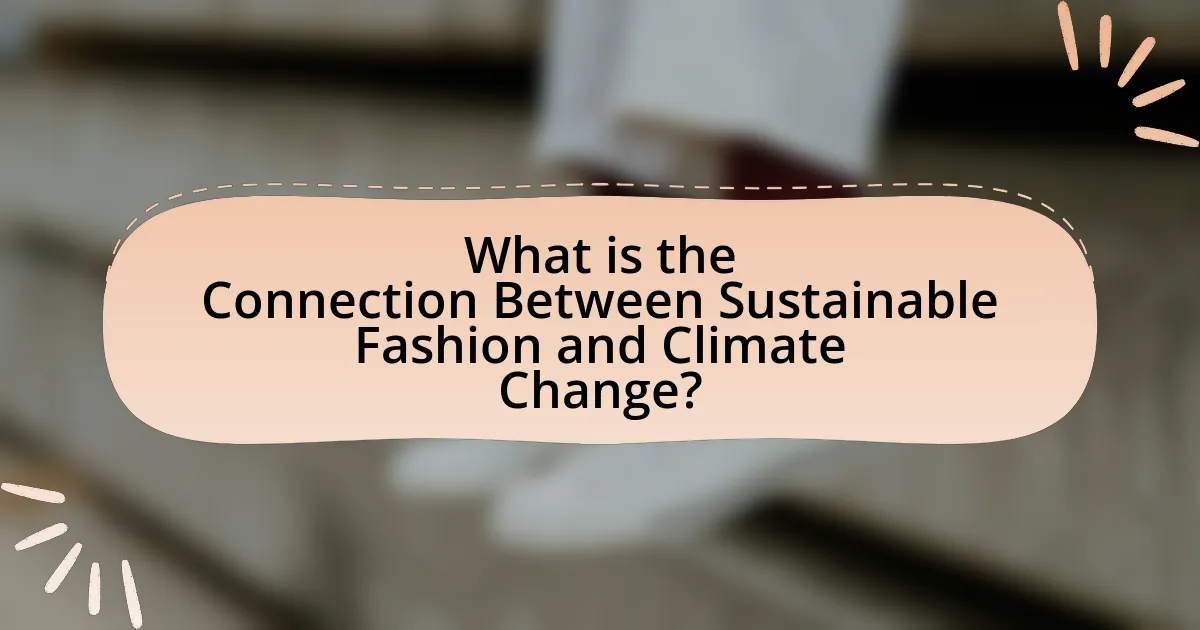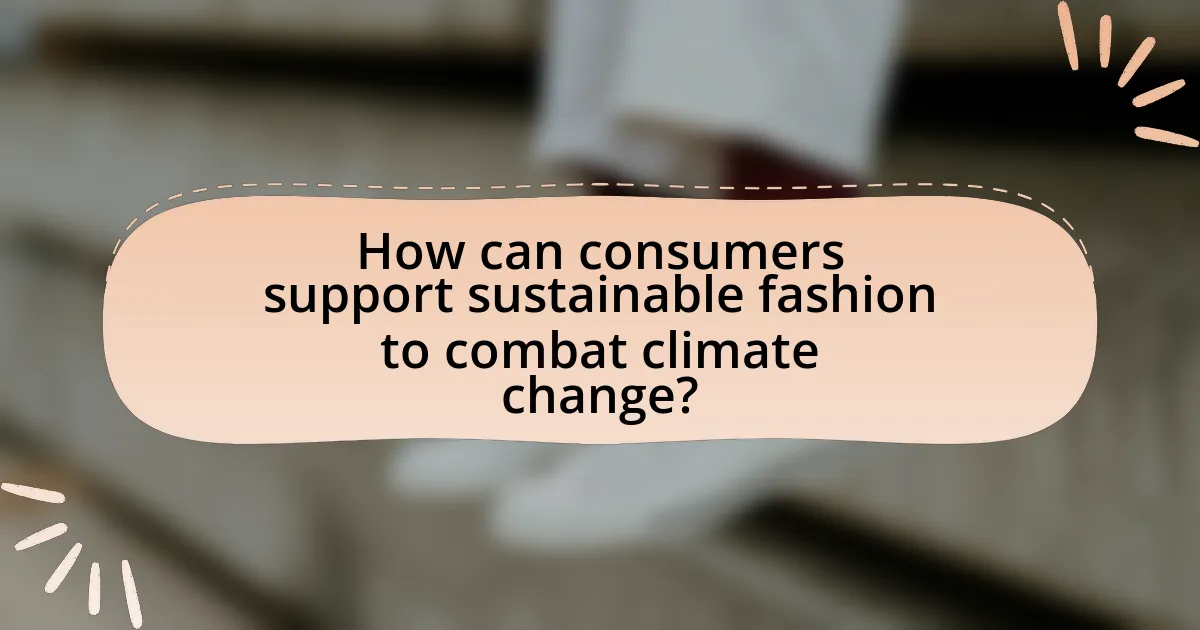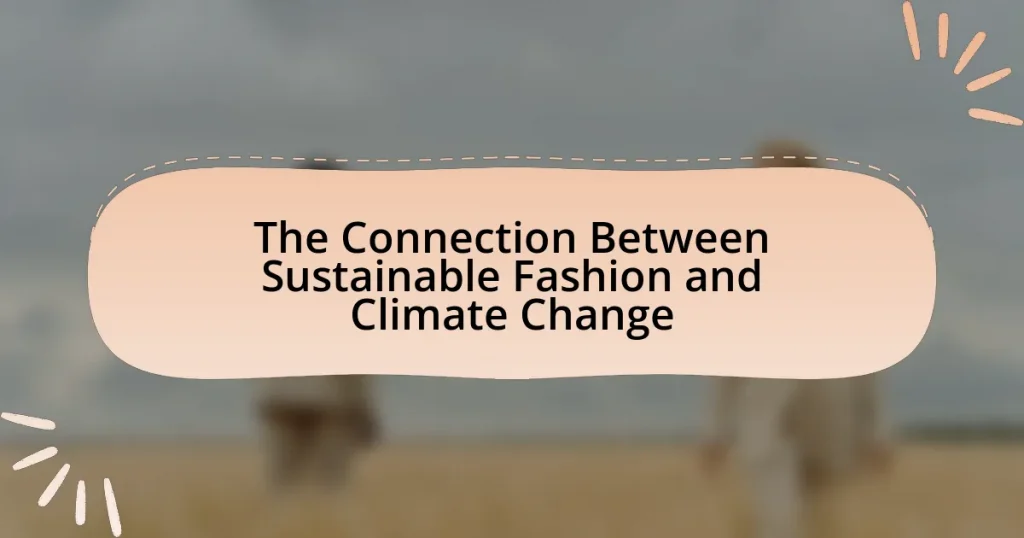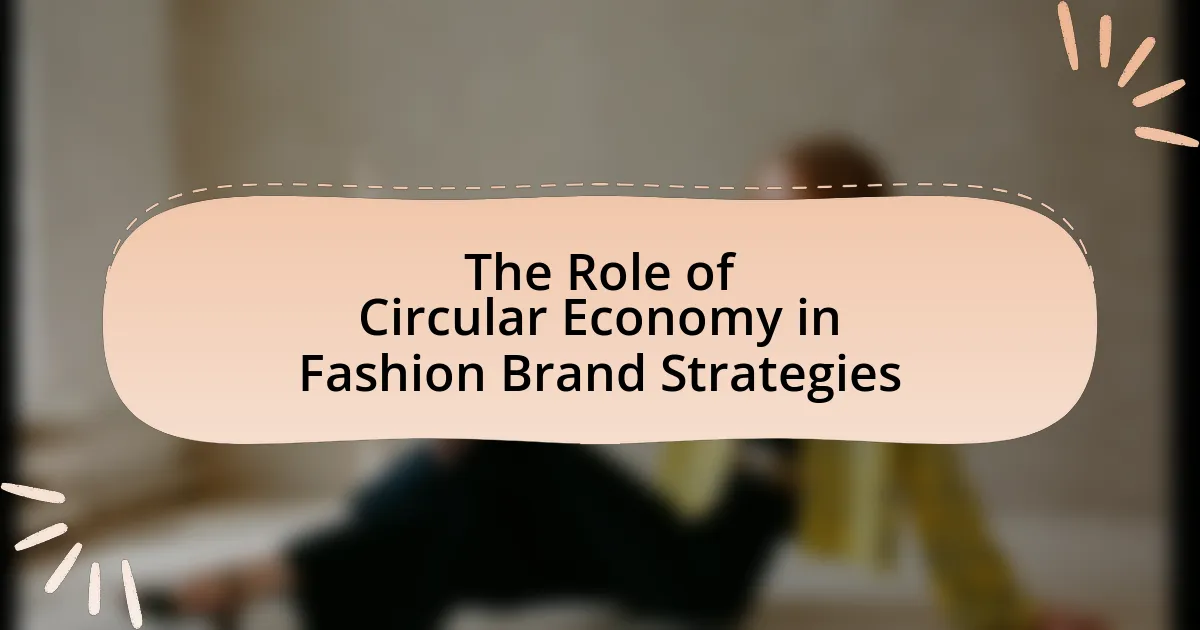Sustainable fashion is a crucial response to climate change, addressing the fashion industry’s significant contribution of approximately 10% to global carbon emissions. This article explores the environmental impacts of traditional fashion practices, highlighting issues such as resource depletion, pollution, and waste generation. It emphasizes the benefits of sustainable practices, including the use of eco-friendly materials, ethical production methods, and circular economy principles, which can significantly reduce carbon emissions and promote climate resilience. Additionally, the article discusses the role of consumer behavior in driving demand for sustainable fashion and outlines practical steps individuals can take to support eco-friendly practices, ultimately contributing to climate change mitigation efforts.

What is the Connection Between Sustainable Fashion and Climate Change?
Sustainable fashion directly addresses climate change by promoting environmentally friendly practices in the production and consumption of clothing. The fashion industry is responsible for approximately 10% of global carbon emissions, largely due to resource-intensive processes and waste generation. Sustainable fashion aims to reduce this impact through methods such as using organic materials, minimizing water usage, and implementing recycling programs. For instance, a study by the Ellen MacArthur Foundation highlights that shifting to a circular economy in fashion could reduce greenhouse gas emissions by 44% by 2030. This connection underscores the importance of adopting sustainable practices to mitigate climate change effects.
How does sustainable fashion impact climate change?
Sustainable fashion significantly reduces climate change by minimizing carbon emissions and resource consumption associated with clothing production. Traditional fashion contributes approximately 10% of global carbon emissions, largely due to energy-intensive manufacturing processes and the use of non-renewable resources. In contrast, sustainable fashion practices, such as using organic materials, recycling, and ethical production methods, can lower these emissions by up to 50%. For instance, a study by the Ellen MacArthur Foundation highlights that adopting circular economy principles in fashion could reduce greenhouse gas emissions by 44% by 2030. Thus, sustainable fashion directly impacts climate change by promoting environmentally friendly practices that decrease the industry’s carbon footprint.
What are the environmental effects of traditional fashion practices?
Traditional fashion practices significantly contribute to environmental degradation through resource depletion, pollution, and waste generation. The production of textiles often requires large amounts of water; for instance, it takes approximately 2,700 liters of water to produce a single cotton t-shirt. Additionally, the use of synthetic fibers, such as polyester, leads to microplastic pollution in oceans, harming marine life. Traditional dyeing processes frequently involve toxic chemicals, which can contaminate water sources and affect local ecosystems. Furthermore, the fast fashion model, rooted in traditional practices, results in massive amounts of textile waste, with an estimated 92 million tons discarded globally each year. These factors collectively illustrate the detrimental environmental effects of traditional fashion practices.
How does sustainable fashion reduce carbon emissions?
Sustainable fashion reduces carbon emissions primarily by utilizing eco-friendly materials and production processes that minimize environmental impact. For instance, organic cotton and recycled fabrics require less energy and water compared to conventional materials, leading to lower greenhouse gas emissions during cultivation and manufacturing. Additionally, sustainable fashion brands often implement practices such as local sourcing and ethical labor, which further decrease transportation emissions and promote a circular economy. According to a 2021 report by the Global Fashion Agenda, transitioning to sustainable practices could reduce the fashion industry’s carbon footprint by 30% by 2030, highlighting the significant potential for emissions reduction through sustainable fashion initiatives.
Why is sustainable fashion important in the context of climate change?
Sustainable fashion is important in the context of climate change because it significantly reduces the environmental impact of the fashion industry, which is responsible for approximately 10% of global carbon emissions. By utilizing eco-friendly materials, ethical production practices, and promoting circular economy principles, sustainable fashion minimizes waste and resource depletion. For instance, the production of organic cotton uses 91% less water than conventional cotton, highlighting the potential for sustainable practices to mitigate climate-related issues.
What role does consumer behavior play in sustainable fashion?
Consumer behavior significantly influences sustainable fashion by driving demand for eco-friendly products and practices. When consumers prioritize sustainability in their purchasing decisions, brands are compelled to adopt more environmentally responsible practices, such as using organic materials and reducing waste. Research indicates that 66% of global consumers are willing to pay more for sustainable brands, highlighting the impact of consumer preferences on market trends. This shift in behavior not only encourages brands to innovate but also fosters a culture of sustainability within the fashion industry, ultimately contributing to climate change mitigation efforts.
How can sustainable fashion contribute to climate resilience?
Sustainable fashion contributes to climate resilience by reducing environmental impact through eco-friendly materials and ethical production practices. By utilizing organic fibers, recycled materials, and low-impact dyes, sustainable fashion minimizes greenhouse gas emissions and resource depletion. For instance, the use of organic cotton can reduce water consumption by up to 91% compared to conventional cotton farming. Additionally, sustainable fashion promotes circular economy principles, encouraging recycling and upcycling, which further decreases waste and pollution. This approach not only helps mitigate climate change but also enhances the ability of communities to adapt to its effects by fostering local economies and sustainable livelihoods.

What are the key principles of sustainable fashion?
The key principles of sustainable fashion include ethical production, resource efficiency, and circularity. Ethical production emphasizes fair labor practices and humane working conditions, ensuring that workers are treated justly throughout the supply chain. Resource efficiency focuses on minimizing waste and using sustainable materials, such as organic cotton or recycled fabrics, to reduce environmental impact. Circularity promotes the idea of designing products for longevity and recyclability, encouraging consumers to participate in recycling and upcycling initiatives. These principles collectively aim to mitigate the negative effects of the fashion industry on climate change by reducing carbon footprints and promoting sustainable practices.
How do materials used in sustainable fashion differ from conventional materials?
Materials used in sustainable fashion differ from conventional materials primarily in their sourcing, production processes, and environmental impact. Sustainable fashion materials are often derived from organic, recycled, or renewable sources, such as organic cotton, Tencel, or recycled polyester, which minimize harm to ecosystems and reduce waste. In contrast, conventional materials frequently rely on synthetic fibers like polyester and nylon, derived from petroleum, and involve chemical-intensive processes that contribute to pollution and resource depletion. For instance, the production of conventional cotton consumes large amounts of water and pesticides, while sustainable alternatives aim to reduce water usage and eliminate harmful chemicals, thereby promoting a more eco-friendly approach to fashion.
What are the benefits of using organic and recycled materials?
Using organic and recycled materials significantly reduces environmental impact and promotes sustainability. Organic materials are grown without synthetic pesticides and fertilizers, which minimizes soil and water pollution, while recycled materials decrease waste in landfills and reduce the need for virgin resources. For instance, the use of recycled polyester can save up to 60% of energy compared to producing new polyester from petroleum. Additionally, organic cotton farming uses 91% less water than conventional cotton farming, highlighting the resource conservation benefits. These practices contribute to lower carbon emissions, aligning with efforts to combat climate change.
How do sustainable materials affect the lifecycle of fashion products?
Sustainable materials significantly enhance the lifecycle of fashion products by reducing environmental impact and promoting resource efficiency. These materials, such as organic cotton, recycled polyester, and Tencel, require less water and energy during production compared to conventional fabrics, thereby minimizing carbon emissions. For instance, a study by the Ellen MacArthur Foundation indicates that using recycled polyester can reduce greenhouse gas emissions by up to 75% compared to virgin polyester. Additionally, sustainable materials often lead to longer-lasting products, as they are designed with durability in mind, which decreases the frequency of replacement and waste. This shift towards sustainability not only benefits the environment but also aligns with consumer demand for eco-friendly products, ultimately fostering a more responsible fashion industry.
What practices define sustainable fashion production?
Sustainable fashion production is defined by practices that minimize environmental impact and promote social responsibility. Key practices include using eco-friendly materials, such as organic cotton and recycled fabrics, which reduce resource consumption and waste. Additionally, sustainable fashion emphasizes ethical labor practices, ensuring fair wages and safe working conditions for workers. Implementing circular economy principles, such as recycling and upcycling, further contributes to sustainability by extending the lifecycle of garments. According to the Global Fashion Agenda’s 2021 report, adopting these practices can significantly reduce the fashion industry’s carbon footprint, which is responsible for approximately 10% of global greenhouse gas emissions.
How does ethical labor contribute to sustainability in fashion?
Ethical labor contributes to sustainability in fashion by ensuring fair wages and safe working conditions, which promote social equity and reduce exploitation. When brands prioritize ethical labor practices, they often engage in sustainable sourcing and production methods, minimizing environmental impact. For instance, a report by the Ethical Fashion Forum indicates that ethical labor practices can lead to a 30% reduction in waste and pollution, as companies adopt more responsible manufacturing processes. This alignment of social responsibility with environmental stewardship fosters a holistic approach to sustainability in the fashion industry.
What are the implications of sustainable manufacturing processes on climate change?
Sustainable manufacturing processes significantly reduce greenhouse gas emissions, which directly mitigates climate change. By utilizing renewable energy sources, optimizing resource efficiency, and minimizing waste, these processes lower the carbon footprint associated with production. For instance, a study by the Ellen MacArthur Foundation found that transitioning to a circular economy in the fashion industry could reduce global carbon emissions by 44% by 2030. This demonstrates that sustainable practices not only contribute to environmental preservation but also play a crucial role in combating climate change.

How can consumers support sustainable fashion to combat climate change?
Consumers can support sustainable fashion to combat climate change by choosing to buy from brands that prioritize eco-friendly materials and ethical production practices. This choice reduces the demand for fast fashion, which is responsible for significant carbon emissions and waste. According to the Ellen MacArthur Foundation, the fashion industry contributes to 10% of global carbon emissions, highlighting the importance of consumer influence in shifting towards sustainable practices. By opting for second-hand clothing, participating in clothing swaps, and supporting local artisans, consumers can further minimize their environmental impact and promote a circular economy in fashion.
What are practical ways for consumers to choose sustainable fashion?
Consumers can choose sustainable fashion by prioritizing brands that use eco-friendly materials, such as organic cotton or recycled fabrics. Research indicates that the fashion industry is responsible for about 10% of global carbon emissions, highlighting the importance of selecting brands that minimize their environmental impact. Additionally, consumers should look for certifications like Fair Trade or Global Organic Textile Standard (GOTS), which ensure ethical production practices. Supporting second-hand shops and clothing swaps also reduces waste and promotes a circular economy, further contributing to sustainability. By making informed choices, consumers can significantly influence the fashion industry’s environmental footprint.
How can consumers identify sustainable brands?
Consumers can identify sustainable brands by looking for certifications such as Fair Trade, Global Organic Textile Standard (GOTS), and B Corp, which indicate adherence to environmental and social standards. These certifications provide assurance that brands meet specific criteria regarding ethical sourcing, production practices, and environmental impact. Additionally, consumers can examine a brand’s transparency regarding its supply chain, materials used, and labor practices, as brands committed to sustainability often share detailed information about their operations. Research shows that brands with sustainable practices typically report lower carbon footprints and engage in responsible waste management, further validating their commitment to sustainability.
What role does second-hand shopping play in sustainable fashion?
Second-hand shopping significantly contributes to sustainable fashion by extending the lifecycle of clothing and reducing waste. This practice minimizes the demand for new garments, which often require substantial resources for production, including water, energy, and raw materials. According to a report by the Ellen MacArthur Foundation, extending the life of clothes by just nine months can reduce carbon, water, and waste footprints by 20-30%. By choosing second-hand items, consumers actively participate in a circular economy, promoting reuse and decreasing the environmental impact associated with fast fashion.
What are the challenges facing sustainable fashion in addressing climate change?
Sustainable fashion faces several challenges in addressing climate change, primarily due to the industry’s reliance on resource-intensive materials and processes. The production of conventional textiles often involves significant water usage, chemical pollution, and greenhouse gas emissions. For instance, the fashion industry is responsible for approximately 10% of global carbon emissions, according to the United Nations Environment Programme. Additionally, the fast fashion model promotes overconsumption and waste, leading to increased landfill contributions and further environmental degradation. The transition to sustainable practices is hindered by high costs of eco-friendly materials, lack of consumer awareness, and insufficient regulatory frameworks that fail to incentivize sustainable practices effectively.
How do economic factors influence the adoption of sustainable practices in fashion?
Economic factors significantly influence the adoption of sustainable practices in fashion by determining the cost structures and profitability of sustainable materials and processes. When sustainable options are more expensive than conventional alternatives, brands may hesitate to adopt them due to concerns about profit margins. For instance, a report by McKinsey & Company highlights that the cost of sustainable materials can be up to 30% higher than traditional materials, which can deter brands from making the switch. Additionally, consumer willingness to pay a premium for sustainable products is crucial; research indicates that 66% of global consumers are willing to pay more for sustainable brands, but this varies by market and demographic. Therefore, economic incentives, such as subsidies for sustainable practices or increased consumer demand for eco-friendly products, can drive the adoption of sustainability in the fashion industry.
What barriers exist for consumers in transitioning to sustainable fashion?
Barriers for consumers in transitioning to sustainable fashion include high costs, limited availability, lack of awareness, and social norms. High costs deter many consumers, as sustainable clothing often comes with a premium price tag compared to fast fashion alternatives. Limited availability restricts access to sustainable options, particularly in certain geographic areas where eco-friendly brands may not be present. Lack of awareness about the environmental impact of fast fashion and the benefits of sustainable choices further complicates the transition, as many consumers are not informed about the issues at hand. Lastly, social norms and peer pressure can influence purchasing decisions, leading consumers to prioritize trends over sustainability. These factors collectively hinder the shift towards more sustainable fashion practices.
What are the future trends in sustainable fashion related to climate change?
Future trends in sustainable fashion related to climate change include the increased use of circular economy principles, innovative materials, and transparency in supply chains. Circular economy practices, such as recycling and upcycling, aim to minimize waste and reduce the environmental impact of clothing production. For instance, brands like Patagonia and Eileen Fisher are leading the way by implementing take-back programs that encourage consumers to return used garments for recycling. Additionally, the adoption of bio-based and recycled materials, such as Tencel and recycled polyester, is on the rise, as these materials have a lower carbon footprint compared to traditional fabrics. Transparency in supply chains is also becoming crucial, with consumers increasingly demanding information about the environmental practices of brands. According to a 2021 McKinsey report, 67% of consumers consider sustainability when making a purchase, indicating a shift towards more responsible consumer behavior in the fashion industry.
How is technology shaping the future of sustainable fashion?
Technology is shaping the future of sustainable fashion by enabling innovative materials, enhancing supply chain transparency, and promoting circular economy practices. Advanced technologies such as 3D printing and biofabrication allow for the creation of sustainable textiles from organic materials, reducing reliance on harmful chemicals and non-renewable resources. Additionally, blockchain technology provides traceability in the supply chain, ensuring ethical sourcing and production practices, which is crucial for sustainability. According to a report by McKinsey & Company, the adoption of digital technologies in fashion can reduce greenhouse gas emissions by up to 30% by 2030, highlighting the significant impact of technology on sustainable practices in the industry.
What innovations are emerging to further reduce the fashion industry’s carbon footprint?
Innovations such as biofabrication, circular fashion models, and advanced recycling technologies are emerging to further reduce the fashion industry’s carbon footprint. Biofabrication involves creating materials from natural organisms, significantly lowering emissions compared to traditional textile production. Circular fashion models promote the reuse and recycling of garments, minimizing waste and resource consumption; for instance, brands like Stella McCartney are implementing take-back programs to encourage recycling. Advanced recycling technologies, such as chemical recycling, allow for the breakdown of textiles into their raw materials, enabling the production of new fabrics with reduced environmental impact. These innovations collectively contribute to a more sustainable fashion industry by addressing key areas of carbon emissions and resource efficiency.
What steps can individuals take to promote sustainable fashion and mitigate climate change?
Individuals can promote sustainable fashion and mitigate climate change by adopting practices such as buying second-hand clothing, supporting eco-friendly brands, and reducing consumption. Purchasing second-hand clothing extends the lifecycle of garments, thereby decreasing waste and resource use; studies show that extending the life of clothing by just nine months can reduce carbon, water, and waste footprints by 20-30%. Supporting eco-friendly brands that prioritize sustainable materials and ethical production practices encourages the fashion industry to adopt greener methods. Additionally, reducing consumption by embracing minimalism and focusing on quality over quantity helps lower the demand for fast fashion, which is a significant contributor to environmental degradation.




